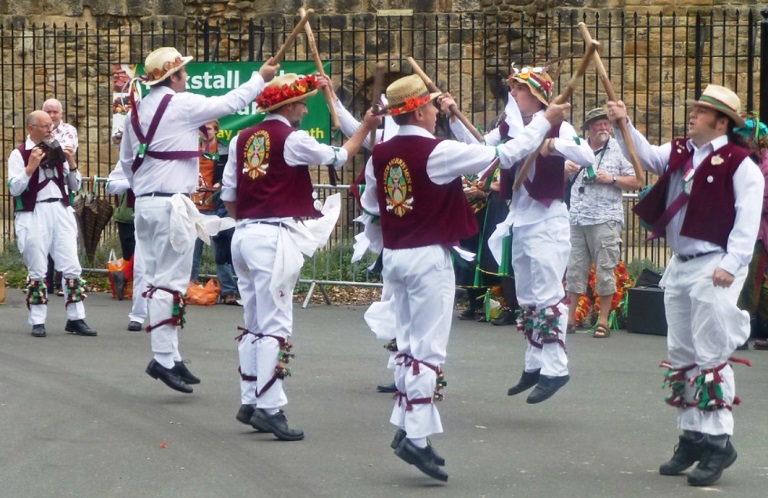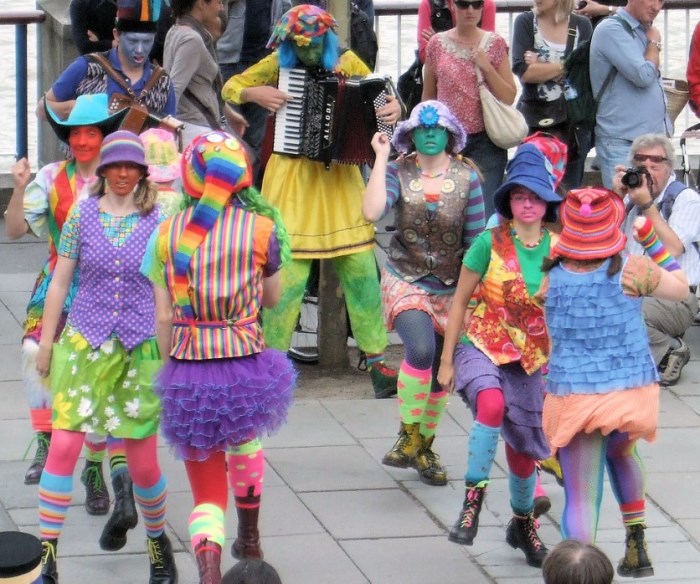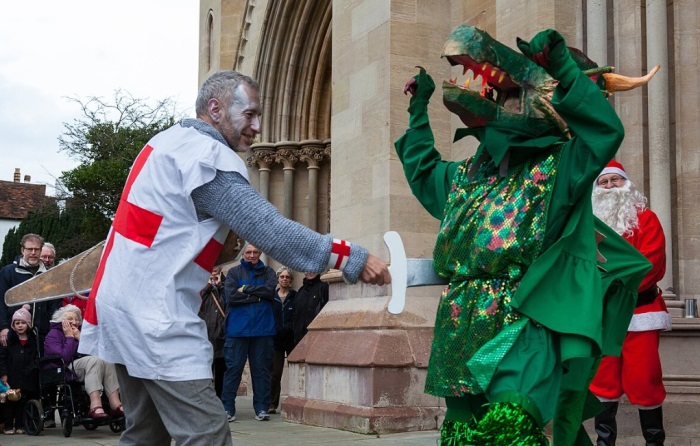The Morris dance is a folk dance that originated and is associated with England, well known for its colorful themes and rigorous movements.
Nowadays, it is seen as a tradition to be preserved and enriched, and young dancers are approaching it again with the intention of giving it a makeover using their creativity.
So, we are going to spend this short reading session getting to know Morris dancing!
Table of Contents
Morris Dance History
The Name
The name “Morris” is believed to derive from the word “morisco”, which translates to “Moorish”.
Collector Cecil Sharp proposed the idea that the term might come from the way dancers painted their faces black as a ritual disguise.
Aside from his suggestion, the connection between “Moorish” and the Morris dance is nearly non-existent.
There is a theory about an English dance coming into existence in the 16th century as the “Moorish” performance, though with a more European style.
It would be a challenge to trace back to the correct events, hence scholars had to make use of records and deductions.
In the London Chronicle, there was a lively dance dedicated to King Henry VII on Christmas 1493 by Spanish dancers wearing bangles.
Even a few decades prior, English terms referred to a “Moorish” dance being put on shows throughout the land of England.
The History in England
In England, the earliest records from the 15th century about the Morris dance placed it as one of the court dances. King Henry VIII had a salt cellar visualizing a Morris performance with five dancers.
In the next century, Morris dancing became associated with the lower classes as well, due to its influence spread with time.
In Nine Daies Wonder, actor William Kempe was chronicled to have danced his way from London to Norwich in Morris style.
It was not until the middle of the 17th century that we got more accurate information about English folk dances. It might be true that the Morris dance transitioned from courtly to rural, but no one could deny the possibility of acquired elements.
The popularity of Morris dance continued to grow until the 1760s when the Industrial Revolution came with significant social changes.
Even so, there are four teams with a self-proclaimed lineage that has never been disrupted in their home village: Abingdon (now under the Hemmings), Heading Quarry, Bampton, and Chipping Campden.
Aside from the big fours, many villages have given their traditions a reboot. With the basic steps and figures of Morris, thousands of dance teams have embraced those traditions and come up with their own unique versions.
Decline and Revival
As the 19th century came to an end, Morris was only a fond memory for people who experienced and loved it.
When singer and teacher D’Arcy Ferris learned about the tradition and the history of Morris dancing, he wanted to bring it back and spent many years traveling to important regions related to Morris dancing and working on its revival.
The most notable names of the preparation phase are Cecil Sharp and Mary Neal, reputed folklorists responsible for collecting crucial materials.
In 1899, Cecil Sharped visited a friend on Boxing Day and watched the Morris side perform. Intrigued by both the dance and the music, he contacted the musician for the tunes.
Mary Neal assisted him in gathering materials for the dances because her female dancers needed new dances for their stages too. And the grand revival came true, brought to life by young ladies.
Morris Today
In 1934, six men’s sides established the Morris Ring, one of the umbrellas in the world of Morris dancing: Cambridge, Letchworth, Thaxted, East Surrey, Greensleeves, and Oxford.
Soon enough, more dance teams were formed, some with female dancers despite the disagreement about the propriety and legitimacy of it.
Back then, the Morris Ring didn’t provide full membership for mixed or women’s sides. The restriction has been lifted now, yet it was possibly the reason for the establishment of the Open Morris and the Morris Federation bodies.
Each of the three bodies has distinctive identities and goals while still working with the other two on certain matters.
Mutual issues that they all have to face such as insurance and public liability as well as grand events are discussed under the Joint Morris Organization.
You will mostly see Morris dancing performed in the festivals of Christmas, Whitsun, May Day, and more. There might be local occasions other than those days that involve the Morris dance.
It is mainly because the Morris dancing represents the best things of the seasons: the fertility of summer, the harvest of autumn, the victory over the dark of winter, and the anticipated arrival of spring.
Morris Dance Styles
The expansive area of influence of the Morris dance has resulted in countless variations from the lands it managed to reach.
Among this variety, I have picked out the most well-known and important styles.
Cotswold Morris
Cotswold is beautiful, though you would be pleasantly surprised to know its Morris variation is highly appreciated too. What we see of Morris today is rooted in an area of the Midlands, including Gloucestershire, Northamptonshire, Oxfordshire, and Warwickshire.
In Cotswold Morris, the performance typically featured 6 – 8 dancers holding handkerchiefs or clapping sticks (sometimes only their hands!).
They mostly wear white shirts and black breeches with a waistcoat and bellpads on top.
North West Morris
By “North West”, I mean the north-western area of England, where the cotton industry has remarkably developed. The cotton workers somewhat inspired the dancers to create a new style of Morris dancing.
An old drawing from 1822 shows a mix of male and female dancers in this dance. Besides the traditional white shirts and red pants, clogs are a rather common part of the costume.
The dance has a rather processional vibe due to the rushbearing celebrations. The dancers will also try to mimic the function of looms and shuttles as a means to wish for another diligent and successful year.
Border Morris
If you want to be specific, I’m referring to the border between England and Wales!
The Border Morris isn’t too different from its brothers and sisters, though the hankie and sticks are extra important. You can recognize the Border style from dancers with painted faces, ribbons on clothes, and bell strips.
The Grand Festival of Glastonbury doesn’t feature the Morris dance, yet the region has a rather well-known dance group specializing in Border Morris.
The number of performers is variable, yet you will see they put so much stress on the stick dance.
Long Sword Dance
Some people see the dance of long swords as a standalone dance style or form, though many consider it a Morris variation.
Despite the name, you won’t see any swords in the performance, only wooden handles and long steel bars.
The dancers usually perform in pairs, each of them holding one end of the prop. A standard set-up might have about four pairs, enough to add more life to the stage without turning it chaotic.
Rapper Sword
If the northwestern area has its Morris variation, so does the southwestern side.
People reserve this lively and energetic dance for cold winter days when it would be fun to watch five dancers connected closely throughout the performance.
Taking after the long sword dance without relying on a sword’s rigid construction, the Rapper Sword dance uses flexible steel bars, which opens up more room for complicated moves.
Dance veterans believe it is impossible to nail the interweaving movements with normal stiff swords.
Molly Dance
The origins of the Molly dancing are in the Cambridgeshire Fens and surrounding areas of the Wash, and its purpose was for the celebrations of Plough Mondays.
You can remember Molly dancing through strikingly colorful and intricate costumes, as well as the prominent footwork of the dancers. Some dance enthusiasts see Molly as one of the more difficult styles of Morris.
Ploughstots
Also known as Phew-lading and Vessel Cupping, Ploughstots influenced the riding from the North to South of Yorkshire, usually performed for the Plough Monday.
Like the handkerchiefs in the Cotswold and Border styles, flags are a signature to draw attention to the dancers’ hands in Ploughstots.
Instead of bells, they use rattling bones, even though the purpose remains the same.
Mummers Plays
If the Morris performance is for New Year or Boxing Day, the local dancers will perform a play called Mummers. It has a hero-combat theme. Due to this nature, Mummers Plays are usually extremely colorful and fun to watch.
The characters often included in the play are Father Christmas, St. George, a Valiant Soldier, and a Knight from Turkey.
They will find and one will fall, but a renowned doctor will show up in time and resuscitate them with a magical concoction!
Morris Dance Moves
The moves in Morris dancing are usually classified as Figures and Steps.
With the Figures, you will have to learn Foot Up, Top Hey, Bottom Hey, Corners Change, and Circular Hey. Each dance has a unique verse figure.
The Steps are likely to be doubled in a pattern of 2 double-steps and then 4 capers. Truncating the second double-step and leaping into the caper can be a challenge for poise and balance.
The hand moves are simply up-and-down, and Morris dancers wave hankies as a demonstration of fighting off the evil spirits.
Morris Dance Music
Most of the records showed that the musical accompaniment for the Morris dance originated from the southern side of the Midlands, involving tabor, pipe, dub, and whistle.
The fiddle came into play around the 1840s and became the primary instrument.
A few decades later, anglo-concerting and melodeon became more popular because they had a perfect sense of the rhythms necessary for Morris dancing.
For more variety, the musicians sometimes included penny whistles, banjo, or even mouth organ.
Since the Morris dance had a strong influence on the people of England and neighboring countries, it ended up having various local versions since every region always has its unique take regarding instruments and melodies.
For example, you will often see one player for Cotswold and Sword styles, while Border Morris tends to feature a band and sometimes a drum if they want to add a powerful element to the show.
Some styles have certain tunes to them, hence the music team will have musicians singing the melodies, preferably as an introduction before the performance.
These songs are more bawdy than formal with a relation to village life or agricultural practices.
Morris Dance Attire: What Do Morris Dancers Wear?
Not too different from the music, the attire of the Morris dance varies greatly depending on the region. You will see more white clothes on the Cotswold side and a predominance of tattered jackets on the Border side.
Morris dancing sticks and handkerchiefs are the most well-known props, though the number of dance teams practicing with swords is not so small at all.
However, the accessories for Morris outfits might be overwhelming if you are a newbie to the dance: bell pads, braces, sashes, rosettes, tattered coats, knee breeches, clogs, neckerchiefs, clogs, armbands, and more.
Final Words
After a crucial revival, the Morris dance is now seen in a different light and gradually included as a part of the mainstream dances.
With enough effort, the young dancers strongly believe they can renew and professionalize Morris and its variations without eliminating the traditional elements.
Reality has proven that the Morris dance can stand in the same place as other art forms.


